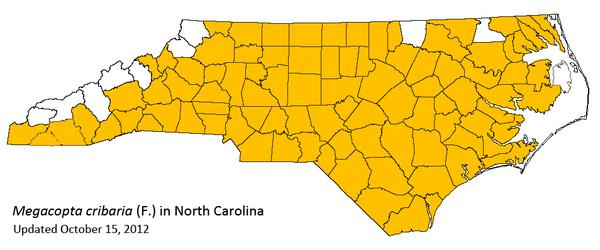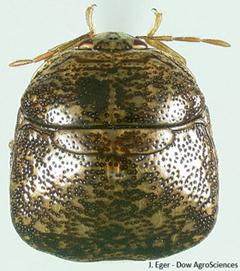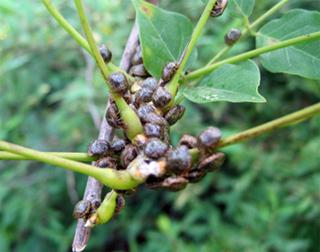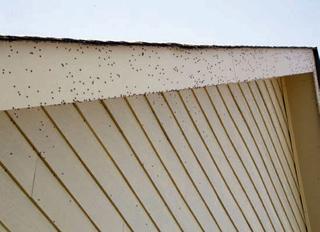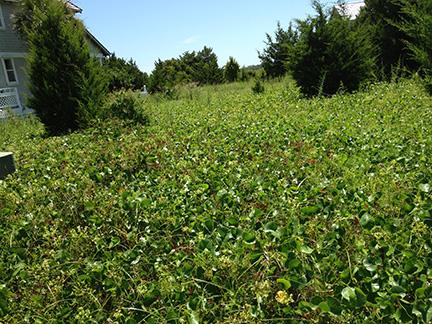Introduction
The kudzu bug, Megacopta cribraria (F.) is also known as the bean plataspid, lablab bug, and globular stink bug. Contrary to "urban legend", kudzu bugs were not released intentionally to control kudzu. They were likely introduced into the U.S. by "hitch-hiking" in a commercial airplane. In 2009, the kudzu bug was reported in nine counties in northeastern Georgia. The following year, the insect had been found in over 60 counties in Georgia and in Macon County, NC. Since then, surveys by the NC State Entomology & Plant Pathology Department and the North Carolina Department of Agriculture & Consumer Services have confirmed the presence of the kudzu bug in kudzu patches, soybean fields, and on other plants such as wisteria in more than 98 North Carolina counties (Figure 1) and in 18 states (check kudzubug.org to see an updated regional map). It is likely present in many other counties but simply has not yet been seen there.
Identification, Biology, and Behavior
Kudzu bugs are 4 to 6 mm long (about 1⁄6 - 1⁄4-inch), somewhat oblong in shape, and olive-green colored with brown speckles (Figure 2). They are "true bugs" and so they have piercing-sucking mouthparts. Aside from kudzu, these insects are known to feed on a wide variety of legumes (soybeans and other bean species, as well as wisteria (Figure 3) and some vetches, Eger et al. 2010). Kudzu bugs have several generations per year. In the spring, they feed extensively in kudzu patches and on other legume hosts. In July-August, they will move into soybeans where they feed on stems and foliage and can have a significant impact on crop yields. The bugs continue to feed and lay eggs into the fall on kudzu, late-planted soybeans, and other hosts.
As these host plants start to decline along with temperatures and day length, kudzu bugs seek out sheltered areas where they can pass the winter, such as under bark or rocks, or in leaf litter, etc. (Figure 4). They are most common along the edges of kudzu patches and soybean fields and in areas near residential areas, we can expect to see them invade homes similarly to the behavior of another nuisance pest - the Asian lady beetle. The bugs will often congregate on light-colored surfaces (such as siding, fascia boards, etc.) as seen in Figure 5. They will then move under siding, or into gaps around doors and windows, or through penetrations such as around air condtioning and water pipes. The following spring, the bugs become active again and begin moving onto kudzu and other early-season host plants, particularly wisteria. Those bugs that overwintered inside homes (e.g., inside walls, attics, etc.) may end up inside the home interior instead of heading outside to food sources. Outdoors, they may also land on siding and deposit their eggs on non-plant surfaces such as brick, vinyl, and other siding materials.
Kudzu Bug Control
Kudzu bugs pose a problem for residences in both the spring and fall. Homes near soybean fields or patches of kudzu are more likely to be invaded by the kudzu bug; however, they are strong fliers and readily move from other overwintering areas. Similarly, the following spring will bring activity as the bugs respond to warming temperatures and look for food sources such as wisteria and kudzu. Although most common household insecticides will kill the bugs upon direct contact, control of the kudzu bug by treating the exterior of homes is unlikely to succeed for several reasons. First, most people do not have the proper equipment to apply an insecticide to areas high up on their homes where the bugs may congregate. Second, because the insects are actively feeding even in the fall, their movement to or from these plantings may take place over several weeks which means several applications (e.g., weekly) may be need to try to reduce their numbers. If you would like to attempt "DIY" pesticides to control kudzu bugs, common home-use products contain "pyrethroid" insecticides such as permethrin, bifenthrin, or lamda-cyhalothrin (look on the product label at the "Active Ingredients" and the chemical name likely ends in "thrin"). Wettable powder formulations of the pesticides that you mix with water may produce "better" results (although they will still not prevent the bugs from invading homes), but these products require mixing in a sprayer and many people prefer "ready-to-use" products. If you use a wettable powder, remember to shake the sprayer periodically so the chemical doesn't settle out. Also, wettable powders may leave a whitish film on the treated surface which be unwanted in very conspicuous areas. When using insecticides, always read and follow the directions for use on the product label. Some important safety tips:
- Be careful when spraying overhead because chemicals will likely drop down on you and objects around you.
- Wear protective clothing and equipment (gloves, goggles, hat, etc.) to keep insecticide off your skin, hair and eyes (Figure 6).
- Always spray downwind relative to where you are standing.
- Be sure to remove or cover objects such as outdoor chairs, grills, swimming and decorative pools, and children's toys.
Read the pesticide labels carefully because many of the common products no longer allow for broadcast exterior treatments (i.e., applications to wide areas of the exterior siding) where pesticides are more likely to be washed off by rain and could run-off into storm drains. Be careful when spraying near ponds and other bodies of water and near hard surfaces (such as sidewalks or driveways) where the chemical is more likely to run into storm drains after heavy rainfall.
Pesticides have limited ability to stop kudzu bugs from entering homes. Long-term control also requires an effort to seal gaps and openings (such as around plumbing and AC lines) to prevent the bugs from entering. Avoid crushing insects that do find their way indoors, as this may stain surfaces and result in unpleasant odors. Instead, gently vacuum up the insects and then place the vacuum bag (or contents) into a trash bag and freeze the bag for several days. You can also drop the bugs into soapy water to kill them. If you simply dump the live insects outdoors, they will likely end up back inside, or, surviving somewhere else around your property.
Removing kudzu patches in neighboring areas (Figure 7) can be helpful but may be difficult unless you get cooperation from the property owner. Treating kudzu for the bugs is difficult without the proper equipment and care must be exercised to make sure the pesticides do not run off into sensitive areas such as wetlands, creeks, etc. The insects are fairly mobile (they crawl and fly) and so even eradicating (or attempting to eradicate) kudzu in or near your yard may not solve the problem.
References
Eger, J. E., Jr., L. M. Ames, D. R. Suiter, T. M. Jenkins, D. A. Rider, and S. E. Halbert. 2010. Occurrence of the Old World bug Megacopta cribraria (F.) (Heteroptera: Plataspidae) in Georgia: A serious home invader and potential legume pest. Insecta Mundi 0121: 1-11.
Megacoptera cribaria as a Nuisance Pest. D.R. Suiter, L. M. Jones, J. E. Eger, and W. A. Gardner. 2010; UGA-CAES Extension Circular No. 991.
Publication date: Oct. 6, 2012
Reviewed/Revised: May 11, 2023
Recommendations for the use of agricultural chemicals are included in this publication as a convenience to the reader. The use of brand names and any mention or listing of commercial products or services in this publication does not imply endorsement by NC State University or N.C. A&T State University nor discrimination against similar products or services not mentioned. Individuals who use agricultural chemicals are responsible for ensuring that the intended use complies with current regulations and conforms to the product label. Be sure to obtain current information about usage regulations and examine a current product label before applying any chemical. For assistance, contact your local N.C. Cooperative Extension county center.
N.C. Cooperative Extension prohibits discrimination and harassment regardless of age, color, disability, family and marital status, gender identity, national origin, political beliefs, race, religion, sex (including pregnancy), sexual orientation and veteran status.

